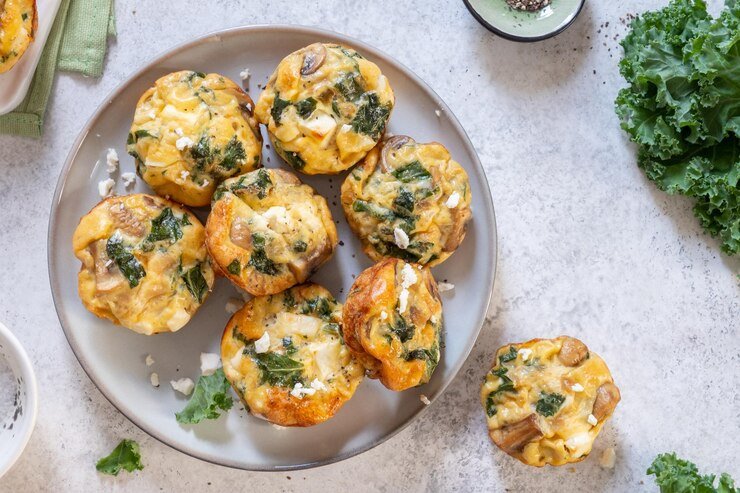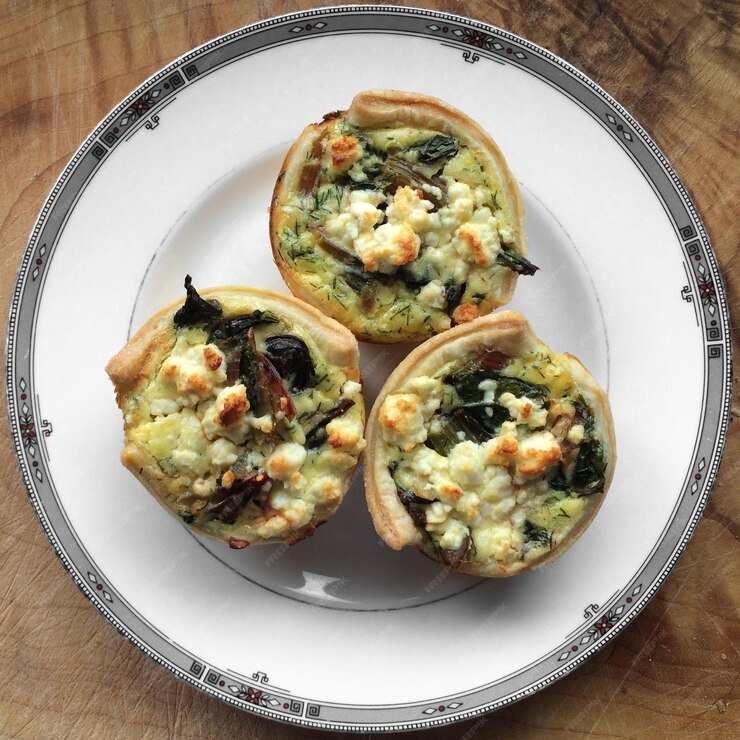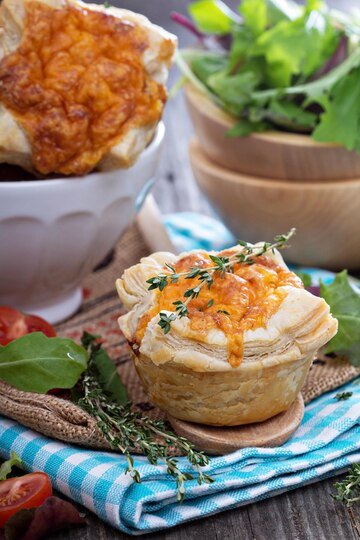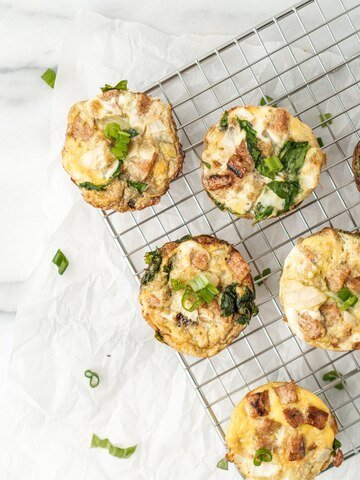If you’re looking for a cozy, plant-based twist on a classic holiday favorite, this Vegan Stuffing Muffins Recipe is the perfect solution. Packed with savory herbs, sautéed veggies, and hearty bread cubes, these stuffing muffins are crispy on the outside and tender on the inside—everything you love about stuffing, but in convenient, muffin-sized portions.
Whether you’re preparing for a vegan Thanksgiving or simply want to add a new side dish to your weeknight dinner, this recipe delivers all the flavor without any animal products. It’s a great way to please a crowd, and even non-vegans will be reaching for seconds.
Plus, they’re easy to make ahead, freeze well, and reheat beautifully. This Vegan Stuffing Muffins Recipe brings comfort and convenience to your table, making it ideal for both festive gatherings and everyday meals. Let’s get into how to make this delicious and wholesome side dish everyone will enjoy.
Equipment Needed

Making Vegan Stuffing Muffins is simple and enjoyable, especially when you have the right tools in your kitchen. From prepping ingredients to baking and serving, having the proper equipment will help ensure your muffins come out perfectly every time. Here’s what you’ll need:
Muffin Tin and Liners
The most essential item for this recipe is a 12-cup standard muffin tin. It shapes the stuffing into individual portions and gives each muffin its signature crispy edges and soft center. You can either use paper liners or lightly grease each cup with oil or vegan butter to prevent sticking. Silicone muffin pans are also a great non-stick, reusable option.
Large Mixing Bowl
A large mixing bowl is important for combining the bread cubes, sautéed vegetables, broth, and seasonings. It gives you enough space to toss everything together evenly without spilling. Choose a bowl that’s wide and deep enough to fold ingredients gently, ensuring each bread piece gets coated with flavor.
Medium Skillet or Sauté Pan
You’ll need a medium-sized skillet or sauté pan to cook your vegetables like onions, celery, and garlic. A non-stick or stainless steel pan works well for this. Cooking the vegetables until soft and fragrant enhances the overall taste of the muffins and brings out the savory herb flavors.
Wooden Spoon or Silicone Spatula
For mixing the ingredients, a wooden spoon or silicone spatula is ideal. These tools are gentle on bread cubes and make it easy to fold in all the ingredients without mashing them. You want the bread to stay somewhat chunky to maintain the muffin structure.
Measuring Cups and Spoons
Precise measurements are crucial in any recipe, and vegan stuffing is no exception. Use measuring cups for the bread and broth, and measuring spoons for your herbs and spices. Getting the right balance of liquid and dry ingredients helps avoid soggy or dry muffins.
Knife and Cutting Board
To prep the vegetables, you’ll need a sharp knife and a sturdy cutting board. Make sure your vegetables are diced evenly so they cook at the same rate and distribute well throughout the mixture.
Cooling Rack
After baking, place the muffins on a cooling rack to prevent the bottoms from getting soggy and to help them set properly. This also allows the muffins to maintain their crispy edges as they cool.
Instructions Step by Step

This Vegan Stuffing Muffins Recipe is the perfect make-ahead side dish for the holidays or a cozy dinner any night of the week. These individual stuffing cups are easy to prepare, filled with rich flavor, and come out of the oven with a perfect golden crust. Follow these step-by-step instructions to create a batch that’s moist, savory, and satisfying.
Step 1: Preheat the Oven and Prep Your Muffin Tin
Start by preheating your oven to 350°F (175°C). Proper preheating ensures the muffins bake evenly and develop that delicious crispy top. While the oven is heating, prepare a 12-cup muffin tin by lightly greasing each cup with a bit of oil or vegan butter. You can also use reusable silicone liners if you prefer a non-stick, eco-friendly option. Set the tin aside until you’re ready to fill it.
Step 2: Sauté the Vegetables
Heat 1 to 2 tablespoons of olive oil in a medium skillet over medium heat. Add 1 chopped onion, 2 celery stalks (diced), and 2 to 3 cloves of minced garlic. Cook the mixture for about 5–7 minutes, stirring occasionally until the vegetables are soft and fragrant. This is your flavor base, so be generous with your sauté time.
If you’re adding fresh herbs like chopped sage, thyme, or rosemary, stir them in during the last minute of cooking so they release their oils and aromas.
Step 3: Prepare the Bread Mixture
Place about 6 cups of cubed, day-old bread in a large mixing bowl. Day-old or slightly stale bread works best because it absorbs the liquid without becoming mushy. Pour the cooked vegetable and herb mixture over the bread cubes. In a separate bowl, whisk together 1½ to 2 cups of vegetable broth, a teaspoon of salt, ½ teaspoon of pepper, and any additional seasonings or nutritional yeast for extra flavor.
Slowly pour the broth over the bread mixture while gently stirring with a spatula to combine. Allow the mixture to rest for a few minutes so the bread can soak up the liquid. You want the bread moist, not soggy, and the mixture should hold together when gently pressed.
Step 4: Fill the Muffin Tin
Once the stuffing mixture is fully combined and has the right texture, spoon it evenly into the prepared muffin tin. Fill each muffin cup generously, pressing the mixture down lightly so it holds its shape while baking. You can let it mound slightly on top for that rustic, crispy muffin appearance. Make sure not to compact the mixture too much, or the muffins may become dense instead of fluffy.
Step 5: Bake the Stuffing Muffins
Transfer the muffin tin to the preheated oven and bake for 25 to 30 minutes, or until the tops are golden brown and crisp. You may want to rotate the tin halfway through baking to ensure even browning. If you love an extra-crispy top, switch to broil for the final 1–2 minutes—just keep a close eye so they don’t burn. The aroma of the toasted bread and herbs will let you know they’re just about ready.
Step 6: Cool and Serve
Once baked, remove the muffin tin from the oven and let the stuffing muffins cool in the pan for about 5 minutes. This helps them set and makes them easier to remove. Use a small knife or offset spatula to gently loosen the edges of each muffin, then transfer them to a cooling rack. These stuffing muffins are best served warm and pair beautifully with vegan gravy, mashed potatoes, or roasted vegetables.
Tips for the Best Vegan Stuffing Muffins

Perfecting your Vegan Stuffing Muffins is all about technique, texture, and flavor balance. Whether you’re preparing them for a holiday dinner or a weeknight side, these helpful tips will guide you to muffin success every time.
Use Day-Old or Toasted Bread for the Right Texture
For stuffing muffins that hold their shape but stay moist on the inside, always use day-old or toasted bread cubes. Fresh bread tends to get too soft and soggy when mixed with broth. If your bread is still fresh, cube it and bake it in the oven at 300°F (150°C) for about 10–15 minutes until it’s slightly crisp. This helps it soak up the liquid without falling apart.
Don’t Over-Saturate the Bread Mixture
It’s tempting to add extra broth, but too much liquid can result in mushy muffins that won’t hold together. Pour the broth gradually and mix gently. The mixture should be well-moistened but still chunky. A good rule of thumb: if the bread holds its shape when lightly pressed, you’re good to go.
Sauté Veggies for Enhanced Flavor
Take the time to properly sauté your onions, garlic, and celery until they’re soft and fragrant. This simple step makes a huge difference in flavor. Adding fresh herbs like sage, thyme, or rosemary while sautéing also boosts the aroma and taste, giving your muffins that traditional stuffing feel.
Pack the Muffin Cups Firmly but Not Tightly
When filling the muffin tin, gently press the mixture into each cup so it stays together as it bakes. However, avoid packing it down too tightly, as this can make the muffins dense. A light hand ensures crispy edges and a soft, flavorful center.
Let Muffins Rest Before Removing
After baking, let the muffins cool in the tin for at least five minutes. This allows them to firm up, making it easier to remove them without falling apart. Use a butter knife or offset spatula to gently loosen the edges before transferring them to a cooling rack.
Make-Ahead and Reheating Instructions

One of the best things about Vegan Stuffing Muffins is how convenient they are to make ahead and reheat. Whether you’re preparing for a holiday meal or just want to save time during a busy week, these muffins hold up beautifully when stored and reheated properly. Here’s how to keep them tasting fresh and delicious.
How to Make Vegan Stuffing Muffins Ahead of Time
If you’re planning ahead, you can easily prepare the entire recipe a day or two before serving. Simply follow all the steps up to baking. After filling the muffin tin with the stuffing mixture, cover it tightly with plastic wrap or foil and refrigerate it for up to 24 hours. This allows the flavors to deepen while keeping everything fresh.
Alternatively, you can fully bake the muffins, let them cool completely, and store them in an airtight container in the refrigerator. They’ll stay fresh for up to 4 days and still taste great when reheated.
Storing Leftover Stuffing Muffins
To store leftover muffins, allow them to cool to room temperature first. Then, transfer them to an airtight container or resealable bag and place them in the refrigerator. You can also freeze them if you want to keep them for longer—just wrap each muffin individually in foil or plastic wrap and store them in a freezer-safe bag. They can be frozen for up to 2 months.
Reheating Instructions for Best Results
When you’re ready to enjoy your muffins, reheating them the right way will bring back their crispy tops and warm, tender centers. For refrigerated muffins, preheat your oven to 350°F (175°C) and place the muffins on a baking sheet. Bake for about 10–12 minutes, or until heated through. To get extra-crispy tops, you can broil them for the last minute—just keep a close eye to avoid burning.
If you’re reheating from frozen, let the muffins thaw in the refrigerator overnight for best results. Then follow the same oven reheating steps. You can also reheat them directly from frozen by adding an extra 5–7 minutes to the baking time.
Variations and Substitutions
One of the best parts about making Vegan Stuffing Muffins is how customizable they are. Whether you’re working with what you have on hand or adjusting for dietary needs, there are plenty of ways to tweak the recipe without losing the comforting flavors you love. Here are some easy and delicious variations and substitutions to try.
Bread Options
While traditional white or sourdough bread works great, you can switch things up depending on your preference. Use whole grain bread for a heartier texture or gluten-free bread if you’re avoiding gluten. Just make sure any bread you use is slightly stale or toasted to prevent soggy muffins. Cornbread can also add a slightly sweet, Southern twist to the recipe.
Vegetable Add-Ins
Feel free to get creative with your vegetables. Along with onions and celery, you can add diced carrots, mushrooms, or bell peppers for more flavor and color. Just be sure to sauté them until soft so they blend well into the mixture. You can also stir in a handful of chopped spinach or kale for an added nutritional boost.
Herb and Spice Variations
Classic stuffing flavors come from herbs like sage, thyme, and rosemary, but you can experiment with others like oregano, parsley, or even a pinch of nutmeg for a warming note. Prefer a spicier kick? Add a sprinkle of red pepper flakes or a dash of cayenne pepper to the mix.
Nut and Fruit Additions
To give your muffins more texture and depth, try adding chopped walnuts, pecans, or slivered almonds. These bring a satisfying crunch and nutty flavor. For a sweet-savory combo, stir in dried cranberries, raisins, or chopped apples—especially great for holiday meals.
Broth and Moisture Adjustments
If you’re out of vegetable broth, you can use mushroom broth for a richer, earthier taste. Want a buttery flavor without dairy? Try using a good-quality vegan butter melted into the broth before mixing it in.
Protein Boost
Make your muffins more filling by mixing in cooked lentils, chickpeas, or crumbled vegan sausage. These protein-rich add-ins turn your side dish into a hearty, standalone meal.
Serving Suggestions
Vegan Stuffing Muffins are as versatile as they are delicious. Whether you’re serving them for a holiday feast, a cozy weeknight dinner, or a meal prep lunch, these savory muffins pair beautifully with a wide range of dishes. Here are some tasty and practical serving ideas to help you get the most out of this comforting recipe.
Perfect for Holiday Meals
These muffins make a great addition to any Thanksgiving or Christmas dinner. Their individual portions are ideal for serving a crowd without the hassle of scooping traditional stuffing. Serve them alongside classic dishes like mashed potatoes, vegan gravy, cranberry sauce, and roasted vegetables for a festive and satisfying meal. They also pair beautifully with a vegan roast or lentil loaf.
Great as a Side Dish
Even beyond the holidays, vegan stuffing muffins make a hearty and flavorful side dish for everyday dinners. Serve them with soups like butternut squash, lentil, or tomato basil for a comforting and well-rounded plate. They’re also great alongside vegan casseroles, stuffed bell peppers, or a warm grain bowl with seasonal veggies.
Make It a Main Course
Add protein-rich ingredients like chickpeas, lentils, or vegan sausage to the stuffing mix, and these muffins can easily become a standalone entrée. Pair them with a crisp green salad, roasted sweet potatoes, or steamed broccoli to create a balanced, protein-packed meal.
Ideal for Meal Prep and On-the-Go
Because they hold their shape so well, stuffing muffins are perfect for meal prep. Store a few in the fridge and reheat them as needed for a quick lunch or dinner. They also make a great portable lunch—just pack one or two with a side of greens or a grain salad, and you’ve got a wholesome meal ready to go.
Serve with Sauces for Extra Flavor
Enhance the flavor of your muffins with delicious sauces or dips. Drizzle them with vegan mushroom gravy, cashew cream, or a savory tahini dressing. For a hint of sweetness, a dollop of apple chutney or cranberry compote works wonderfully, especially during the fall and winter seasons.
FAQs
What Type Of Bread Works Best For Vegan Stuffing Muffins?
You’ll get the best texture when you use day-old or slightly stale bread, as it absorbs the liquid without turning mushy. Sourdough, French, Italian, or whole wheat bread all work well. For a gluten-free version, use a hearty gluten-free loaf.
Toasting the bread cubes in the oven before mixing them with the vegetables and broth also helps create that perfect balance of a moist center and crispy edges.
Can You Make Vegan Stuffing Muffins Ahead Of Time?
Yes, you can easily make vegan stuffing muffins ahead of time. You can prep the entire mixture and refrigerate it in the muffin tin overnight before baking. Or, you can bake the muffins, let them cool, and store them in an airtight container in the fridge for up to 4 days. Just reheat in the oven at 350°F (175°C) for 10–12 minutes before serving.
How Do You Keep The Muffins From Falling Apart?
To help the muffins hold their shape, make sure the bread is moist but not overly saturated. When filling the muffin tin, press the mixture gently into each cup without compacting it too much. Let them rest in the tin for 5 minutes after baking to firm up, and then carefully loosen the edges before removing. This helps keep each muffin perfectly intact.
Can You Freeze Vegan Stuffing Muffins?
Absolutely! Vegan stuffing muffins freeze well and can be stored for up to 2 months. After baking and cooling completely, wrap each muffin individually in plastic wrap or foil and place them in a freezer-safe bag or container. To reheat, let them thaw in the fridge overnight, then bake at 350°F (175°C) for about 10–15 minutes, or until heated through.
What Vegetables And Add-Ins Can You Include?
You can customize your stuffing muffins with a variety of vegetables like carrots, mushrooms, spinach, or bell peppers. For extra flavor and texture, try adding nuts (like walnuts or pecans), dried fruits (like cranberries or raisins), or even cooked vegan sausage or lentils. Fresh herbs like sage, thyme, and rosemary really elevate the flavor and give them a classic stuffing taste.
Conclusion
Vegan Stuffing Muffins are a flavorful, comforting twist on classic stuffing—perfect for holidays or everyday meals. Their individual size makes them easy to serve, store, and enjoy, whether you’re hosting a big dinner or prepping meals for the week. With a savory blend of herbs, vegetables, and hearty bread, these muffins offer all the cozy flavors you love in a simple, plant-based package.
Plus, they’re easy to customize with your favorite add-ins, making them a versatile addition to any table. Whether you enjoy them fresh from the oven or reheated the next day, these stuffing muffins are sure to become a go-to favorite. Try them once, and they’ll be part of your seasonal menu year after year.

